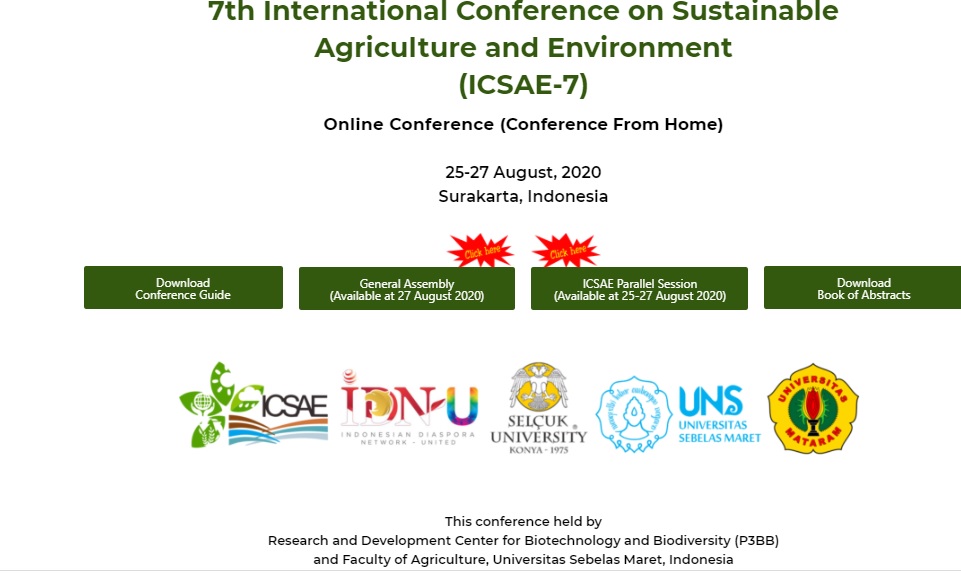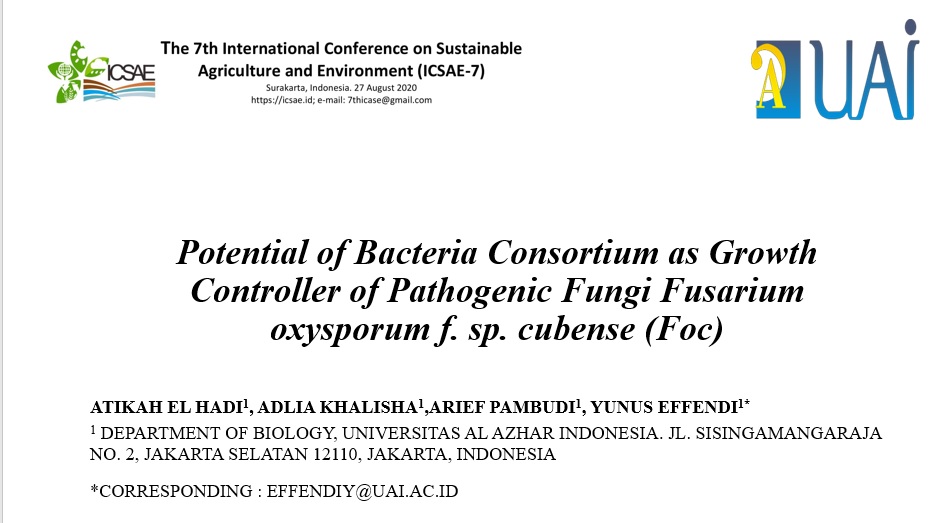Mahasiswa Prodi Biologi Berkarya : Consortium Bacteria Design of Pathogenic Fungi Development Controller Fusarium oxysporum f.sp. cubense (FOC).
7th International Conference on Sustainable Agriculture and Environment (7th ICSAE)
International Conference by Atikah El Hadi

Pada tanggal 25 – 27 Agustus 2020, salah satu mahasiswa Prodi Biologi Fakultas Sains dan Teknologi, Universita Al Azhar Indonesia Atikah El Hadi berhasil mempresentasikan hasil penelitiannya di acara seminar internasional 7th International Conference on Sustainable Agriculture and Environment (7th ICSAE). Penelitian berjudul “Consortium Bacteria Design of Pathogenic Fungi Development Controller Fusarium oxysporum f.sp. cubense (FOC)” dilakukan dibawah bimbingan Dosen prodi Biologi UAI Dr. rer. nat Yunus Effendi dan Arief Pambudi M.Si. Pengembangan sektor terkait menjadi tema dalam seminar international 7th International Conference on Sustainable Agriculture and Environment (7th ICSAE). Kegiatan ini diadakan atau didukung oleh Selcuk University (Turkey), Sebelas Maret University (Indonesia), Mataram University (Indonesia) . Acara ini diselenggarakan sebagai sarana presentasi hasil hasil penelitian yang berkenaan dengan pengelolan di sektor pertanian.

Berikut potongan abstrak dari penelitian yang dilakukan oleh Atikah El Hadi ini.
Banana plants (Musa sp.) on PT Perkebunan Nusantara (PTPN) VIII, Parakansalak, Sukabumi West Java plantation were indicated infected by panama wilt was caused by Fusarium oxysporum f.sp. cubense (Foc). In this case, rhizosphere bacteria is one of a kind of organism, which can be used as a biocontrol to induct the systemic resistance on the plants. This research was done to obtain the designation and evaluate the potential of bacteria consortium, which has the ability to slowed down the growth of the Foc. The candidates of non-pathogenic Foc inhibitor bacteria are being selected through the antagonistic test, pathogenic test, and compatibility test. The effectiveness of inhibition selected bacteria will be tested in-vitro through the greenhouse-scale of suppressive soil experiments. The result shows that the Bacillus cereus strain CCM 2010 and BS 3-4B has the highest percentage of inhibition to the Foc (25.68 – 29.02%). Non-pathogenic bacteria with a percentage of inhibition above 20%, consists of 3 consortia by compatibility testing. 1st consortium (BS 3-4B, Bacillus cereus strain CCM 2010, Staphylococcus arlettae strain ATCC 43957, Bacillus cytotoxicus strain NVH 391-98 and Bacillus pseudomycoides strain NBRC 101232), 2nd consortium (Bacillus cereus strain CCM 2010 and Lysinibacillus xylanilyticus strain XDB9), and 3rd consortium (Lysinibacillus xylanilyticus strain XDB9 dan Bacillus pseudomycoides strain NBRC 101232). Results of the observation show that the infected control plant by Foc having the yellow symptom on the day-3. Meanwhile, the plants with bacterial treatment with Foc, they showed a delay in infection symtomps.

